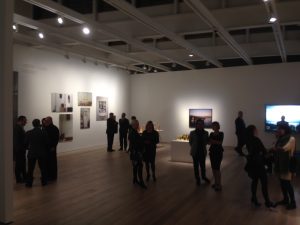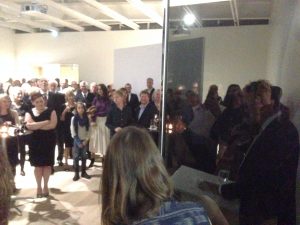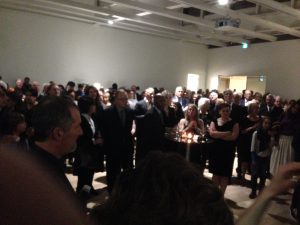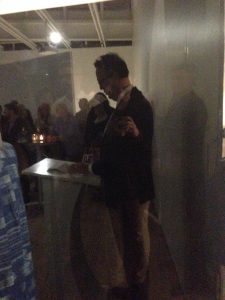



Pictures I took at the Grand Opening
“At a Grand Opening”:
I looked out the window into the darkness of the inlet. The usual scenic views of a seabus trip were gone, besides brightly lit industrial scenes, containers, cranes, and tankers. As the seabus approached the quay, the Polygon appeared out of the darkness too. I could see the gallery was lit up; it was finally alive and running. They were prepared for a big night. I was dressed up myself, not a suit, but a dress shirt and nice winter jacket. I was nervous and hoping I wouldn’t make a fool out of myself since this was a high-profile event. I already feel out of place at big events and more so now I felt like an outsider, some student among these established art world people.
I approached the gallery, which was already crowded with people. It was the first time I actually saw the gallery in action, occupied by people who didn’t work there. I was dazzled; the suits, dresses, lights were a little overwhelming. I saw that you had to go through registration to get in. Hopefully, getting in would be easy. I was definitely invited, but I should’ve asked if I was put on the list. I approached one of the registration people who greeted me very nicely. She asked for my name and I gave it to her. She looked for me. As I expected she couldn’t find me. I mentioned I was “sorta-staff” (should’ve just said staff), having worked on the exhibition. She looked again. Eventually she said it was fine, I could go up. But she seemed to give me a look. She lost her former nicety and gave me a look that made me feel like a kid trying to sneak in. So I went up.
Upstairs, it was already packed. The small upstairs lobby was brimming with people. I tried to navigate the crowd, trying to find people I knew–the staff members that is–but often I would see them with other people. It made sense, they had to give attention to the important people, donors, artists, friends of the gallery, people with a larger stake in the art world. Eventually, after much wandering, I found my supervisor and we talked for a bit and he went off soon after. Then, I ran into the someone else I knew–lets call them M–, who had said she’d introduce me to some people, the exhibiting artists specifically, to get more information for my research. I was first introduced to one artist where I was quickly introduced. M then said she’d be off and she left me there. That was unexpected. I would have hoped she wouldn’t have pushed me into these situations so abruptly. Not that I needed to be babied around, but I was already in a somewhat alien environment. This didn’t help me become more comfortable and I needed to get into top art-knowledgeable-person form fast–don’t make a fool of yourself. I talked to the artist for a bit and it wasn’t too bad. I stumbled over my words a bit and they came out in a rush, but I got my point across (I think). Luckily, it was announced that speeches were about to be made so we all flowed into a large room.
The speeches reminded me how much money was going into the gallery. Speeches came from the director of course, but all the various corporate sponsors of the inaugural exhibition, many who also donated to the gallery itself, the various gallery rooms bearing their names. It was one hugely-moneyed person or corporation representative after another. They were talking about culture; culture backed by a lot of money. It didn’t seem so much an inauguration of the gallery, a new cultural space in Lower Lonsdale, but that so much support, money, had gone into making this dream come true. In fact it’s announced that enough money was donated to back one of the curator’s job indefinitely. There were drinks being served once I stepped into the gallery upstairs. There was a full on bar, catering (I had venison). As well, the opening was supposed to be open only to ‘first members’, membership costing $250. This was a monied event.
Afterwards, everyone shuffled back into the exhibition spaces. Later, M introduced me to someone else, someone who could answer some questions about a work I didn’t totally understand. This person–let’s call them C–was talking to someone else already when M approached him with me in tow. We listened to them talk for awhile before M said something somewhat related and then introduced me. C’s face looked blank at first–who was this kid? Then when M said I was helping out with the exhibition, he flashed a bit of a smile. Then I was left to fend for myself again.
He was by far the hardest person to talk to there. As I said, he was already talking to someone when we approached him. And he continued talking to this person as I stood there. After awhile of talking to this other person, he turned to me and said something along the lines of “don’t be afraid to join the conversation”; I was trying, but it was hard to get what they were talking about. He finally finished his chat and I began to ask my question. In the middle of that, he saw someone else nearby and began talking to them. There was a business talk going on, which was very interesting to hear, but I probably shouldn’t get into it too much here. That ended soon enough as well. I thought I’d get an in again, but he recognized someone yet again. They started to talk about meeting up sometime soon and then that was when he started to explain the work in question (I hadn’t even fully asked mine). After probably 20 minutes or so of talking to C–or, really, not–, I had got some answers.
That’s the last thing I’ll talk about that night. It was an interesting night; I think I learned a lot.










